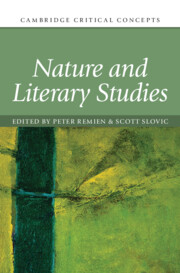Book contents
- Nature and Literary Studies
- Cambridge Critical Concepts
- Nature and Literary Studies
- Copyright page
- Dedication
- Contents
- Figures
- Contributors
- Acknowledgments
- Introduction
- Part I Origins
- Part II Development
- Chapter 7 Romantic Nature
- Chapter 8 The Sublime
- Chapter 9 Toward a Transatlantic Philosophy of Nature
- Chapter 10 Indigenous Naturecultures
- Chapter 11 Postcolonial Nature
- Chapter 12 Extinction
- Chapter 13 Nature in the Anthropocene
- Part III Applications
- Further Reading
- Index
Chapter 8 - The Sublime
from Part II - Development
Published online by Cambridge University Press: 22 July 2022
- Nature and Literary Studies
- Cambridge Critical Concepts
- Nature and Literary Studies
- Copyright page
- Dedication
- Contents
- Figures
- Contributors
- Acknowledgments
- Introduction
- Part I Origins
- Part II Development
- Chapter 7 Romantic Nature
- Chapter 8 The Sublime
- Chapter 9 Toward a Transatlantic Philosophy of Nature
- Chapter 10 Indigenous Naturecultures
- Chapter 11 Postcolonial Nature
- Chapter 12 Extinction
- Chapter 13 Nature in the Anthropocene
- Part III Applications
- Further Reading
- Index
Summary
Prior to shaping literary depictions of a nature classed both wondrous and terrible, sublime discourse addressed uplifting, transporting encounters with the written word. Nicolas Boileau’s influential French translation of Longinus’ ancient treatise On the Sublime (ca. first century CE) restyled the branch of sublime discourse dedicated to discourse itself, suggesting that sublime literature is not elevated simply because it is complex or because it is marked by a high or lofty style. Rather sublime works of verbal art carry a peculiar charge, a charge or spark relayed to audiences taking in sublime textual encounters. This emphasis on a charged sublime encounter would underwrite prominent philosophical and aesthetic accounts of sublime nature penned by Kant, Wordsworth, Burke, and Keats. Such literary representations of sublime nature are famously ambivalent, with aesthetic renderings of earthquakes, fires, or floods bearing out fraught questions of agency. Kantian and Wordsworthian models of sublime nature suggest human agencies of mind transcend vast powers of nature. Burkean and Keatsian accounts of dread nature or astounding material sublimities ultimately humble humankind.
Keywords
- Type
- Chapter
- Information
- Nature and Literary Studies , pp. 161 - 176Publisher: Cambridge University PressPrint publication year: 2022

